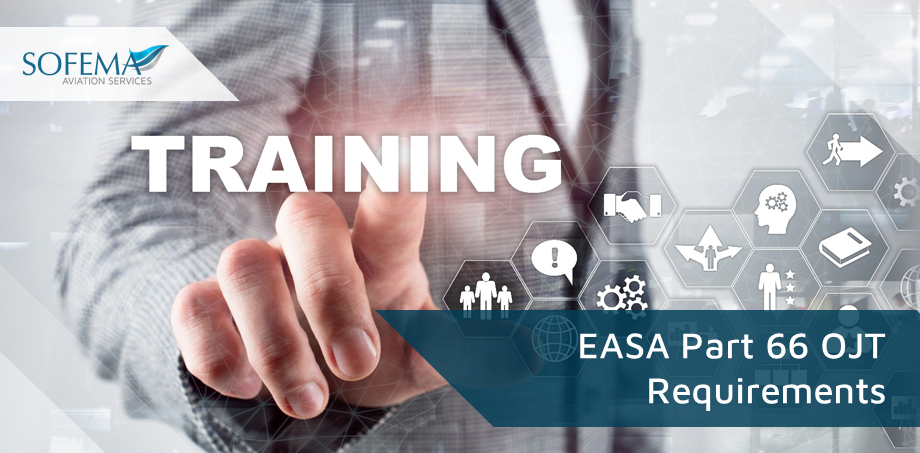Sofema Aviation Services (SAS) www.sassofia.com considers the terms, definitions and differences related to EASA Part 66 OJT Requirements
Introduction
The objective of OJT is to gain the required competence and experience in performing safe maintenance.
OJT assessment addresses the additional practical experience necessary to gain in a true maintenance environment as part of the first type rating in a (sub)category. Whereas the practical assessment addresses the practical portion of any EASA Part 147 type training
OJT belongs to the Maintenance organisation and will be documented in the exposition (chapter 3.15) or “one-off” direct approval
On the Job Training Details & Reference
- The endorsement of the first aircraft type rating, within a given category/sub-category, requires satisfactory completion of the corresponding On-the-Job Training (ref. 66.A.45(c)).
- The OJT shall be approved by the competent authority who has issued the license (ref. Part 66, Appendix III, sec. 6).
- It shall be carried out in a maintenance organisation approved under Part-145 with an A rating and the procedures for OJT should be included in the exposition (MOE chapter 3.15 “OJT procedure”, approved by the competent authority of the maintenance organisation.
Important Notes – Since these procedures are approved by the competent authority of the maintenance organisation, and providing training is not one of the privileges of a maintenance organisation, they can only be used when the licensing authority (the competent authority issuing the license) is the same as the competent authority of the maintenance organisation.
- In other cases, it is up to the licensing authority to decide whether it accepts such procedures to approve the OJT (ref. AMC to Section 6 of Appendix III to Part-66).
- For Part-145, whose principal place of business is located outside the EASA Member States, the competent authority of the maintenance organisation is EASA. In such case, the OJT procedures cannot be included in the MOE, because EASA is not a licensing authority.
- The possibility still exists in this case that a licensing authority may directly approve OJT procedures, which have to be included in a separate document outside (and not being part) of the MOE.
Available Options to Enable OJT:
- Option A: apply directly to the licensing authority that has issued the license for the approval of an OJT (to be proposed in a document outside the MOE).
o This option should normally be considered by organisations and not by individuals.
- Option B: find an agreement to follow an already approved OJT at another organisation, which was approved by the same licensing authority that has issued the license.
- Possibility also exists to follow an OJT which was approved by any other licensing authority, however in such a case the final acceptance of this OJT to endorse the first type rating in the license remains at the sole discretion of the competent authority issuing the license.
Additional Note – It is recommended that before starting any OJT, the licensing authority who has issued the license is contacted to verify its acceptance of any possible intended option.
General Notes related to OJT
- Shall be approved by the competent authority who has issued the licence.
- Shall be conducted at and under the control of a maintenance organisation appropriately approved for the maintenance of the particular aircraft type and shall be assessed by designated assessors appropriately qualified.
- It shall have been started and completed within the 3 years preceding the application for a type rating endorsement.
OJT Content
- OJT shall cover a cross section of tasks acceptable to the competent authority.
- The OJT tasks to be completed shall be representative of the aircraft and systems both in complexity and in the technical input required to complete that task.
- While relatively simple tasks may be included, other more complex maintenance tasks shall also be incorporated and undertaken as appropriate to the aircraft type.
- Each task shall be signed off by the student and countersigned by a designated supervisor.
- The tasks listed shall refer to an actual job card/work sheet, etc.
OJT Assessment
It is sufficient that the completion of individual OJT tasks is confirmed by the direct supervisor(s), without being necessary the direct evaluation of the assessor.
The final assessment of the completed OJT is mandatory and shall be performed by a designated assessor appropriately qualified.
In order to facilitate the verification by the competent authority, demonstration of the OJT shall consist of detailed worksheets/logbook together with a compliance report demonstrating how the OJT meets the requirement of this Part
The following data shall be addressed on the OJT worksheets/logbook:
- Name of Trainee;
- Date of Birth;
- Approved Maintenance Organisation;
- Location;
- Name of supervisor(s) and assessor, (including licence number if applicable);
- Date of task completion;
- Description of task and job card/work order/tech log, etc.;
- Aircraft type and aircraft registration;
- Aircraft rating applied for.
The final assessment is based on a review of the completed OJT, (whereas the candidate’s competence is indirectly justified.)
- To confirm the completion of the required diversity and quantity of OJT, based on the supervisor(s) reports and feedback. Either:
o Continuous during OJT (confirmed by the direct supervisor)
o Summative, as a final evaluation of the completeness of the OJT (based on the supervisor(s) reports and feedback)
Next Steps
Follow this link to our Library to find & download related documents for Free.
Please visit www.sassofia.com or see the following course EASA Part 147 Practical Instructors, Examiners/Assessors Training – Initial – 2 Days/ for comments or questions please contact team@sassofia.com
Tags:
Aircraft, AMC to Part-66 Appendix III 3., EASA Member States, EASA Part 147, EASA Part 66 OJT, Maintenance Organisation, OJT assessment, On the JOB Training, Part 66, SAS blogs




